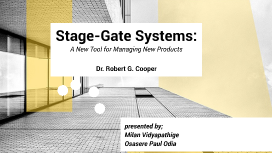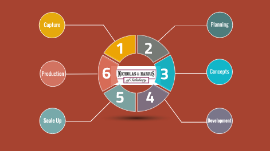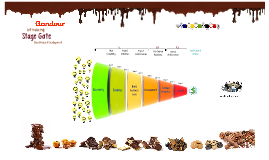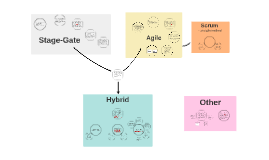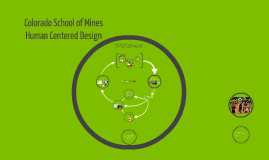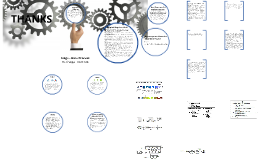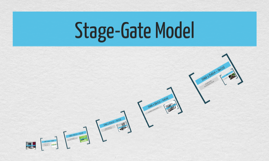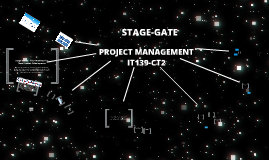Stage - Gate Process
Transcript: THANKS 4. Improve the effectiveness of Gates (Go/Kill decision points) 3. Revitalize fundamental research by making it more productive. Gates are the points where the team converges and where all new information is brought together. Effective gates are essential to the success of a new and accelerated product process, they are quality control check points with Go / Kill / Hold / Modify decisions. Gates provide the funnels, where mediocre projects are culled out at each successive gate, is where are managed the resources required by the project leader and the team for the next stage.. The Stage-Gate® product innovation process is an operational model for the management of a new product development (NPD) process from idea to launch. Its purpose is improve effectiveness and efficiency, by breaking down the effort into stages separated by management decision gates. Misconceptions About the Stage-Gate Process Currently best practices companies, replace their ideation process by a more proactive “Discovery Stage”, including: • An idea capture and handling system, where new ideas from inside and outside the company are provided to a focal person, the focal person brings these new ideas to gate 1 where they are analyzed, those that fit the company strategy will go to stage 1. This process enables the company to seek for differentiated and superior products with unique customer benefit. A good idea has a strong chance to yield a successful product. • Voice of the Customer Research to uncover new opportunities.” Big ideas are solution to solve big problems. Therefore, one way to begin is by focusing on your customer’s problems”. However, since customer rarely know exactly what they want, it is important to tackle their problems and their issues instead of asking about functionality and performance. One solution is to have the customer analyze a current product and determine all that is wrong with it, without being influencing by the company. • Ethno-graphic research, where the company observes the customer using the product at its limits, and experiencing their frustrations about them. • Establish valuable scenario of both present and future, and from them determine alternate scenario as well analyzing market change or market evolution that can partially or totally affect customer desires and therefore product requirements. Alternative scenarios should be assessed in term of best or worst one in the future, the different possible ones, and the type of technology they would require. Stages 1. Myths 2. Criticism about the Stage-Gate® process Criticism about the Stage-Gate® process Best Practices for Implementation Why so many companies implementing Stage-Gate® complain later that their products are not successful and put the blame on the process? The main issue is that their gates are not really a business decision point. These companies use the process as a tunnel and not as a funnel, like it should be the case. They rarely kill projects at gates, which results in too many projects and not enough resources and time to allow for a particular project coming from an outstanding idea. Following are some solutions that could reinforce gates and make them more profitable and useful in the process. • Incorporate tough gates. Insert “gates with teeth”, which means gates with tough criteria where the product capability and suitability to the business orientation is strongly assessed. • Make real decisions at gates. Often the criteria are correctly assessed and a Go decision is made, but the resources are not committed on time to the team. It happens when senior management doesn’t really understand that a go decision at a gate means that a commitment to make resources available had been taken. • Engage senior management. Senior management must be engaged in the NPD process and give visible and meaningful leadership support. Stages are where the action occurs. They are defined by the activities within them, and there is usually a prescribed list of actions for each stage. Stages are designed to gather information in order to reduce project uncertainties and risks, and to allow management to make a decision at the end of the stage and move forward with the project. Therefore, information requirements define the purpose of each stage in the process. 2. Harnessing the creative ability of your entire organization People complain that: Stage-Gate® slows projects and has high overhead. It seems like gates are put in place to slow projects, because a review is required at different steps during the process. And preparing information for these reviews requires working on large amount of paperwork, which disturbs the entire work schedule of team members. It emphasizes more form than substance in discussion and decisions. They report that the process is more focused on the flow of activities than their contents, and that decisions relate only to the stages outputs and not on the process details. They kill innovation. The process does not






